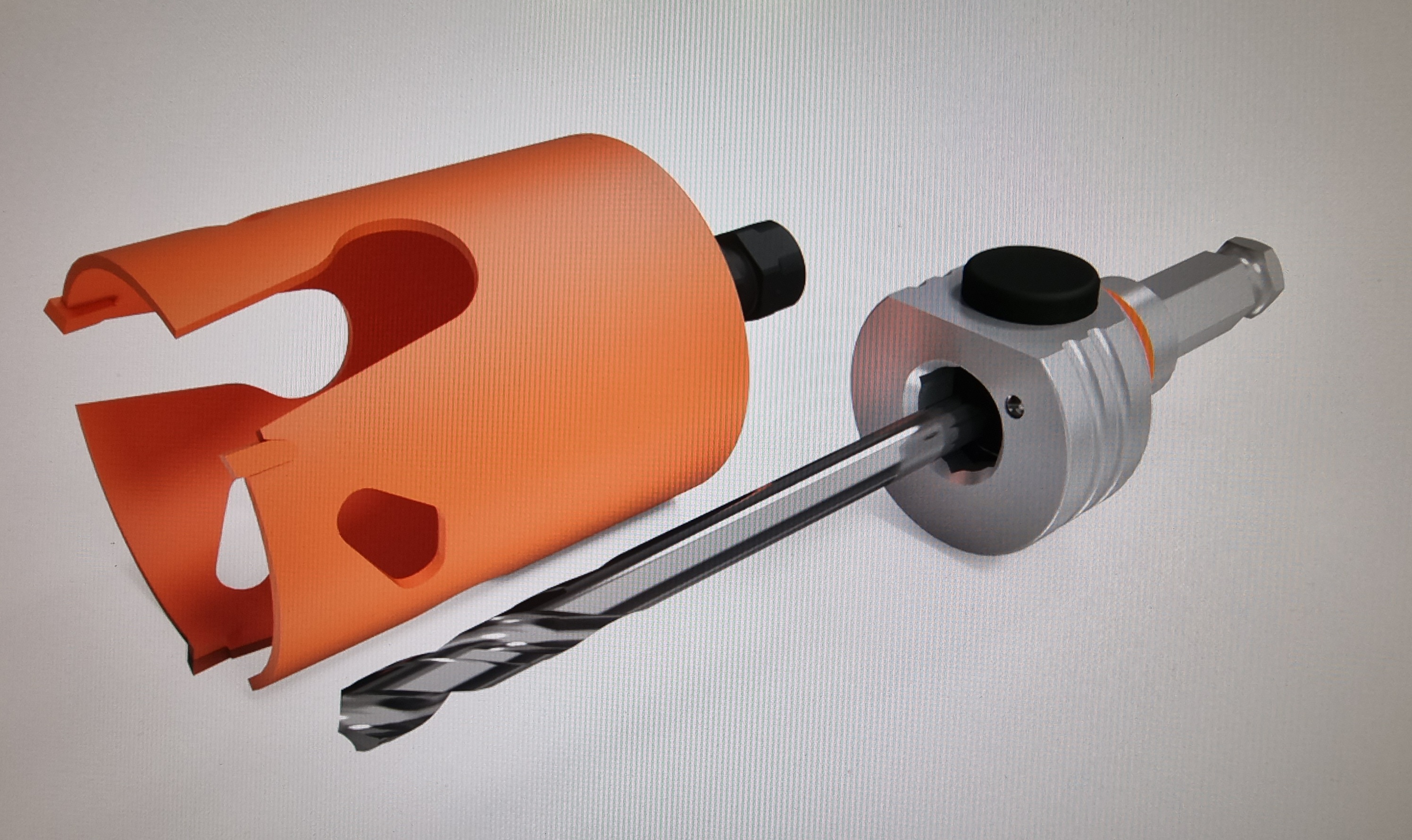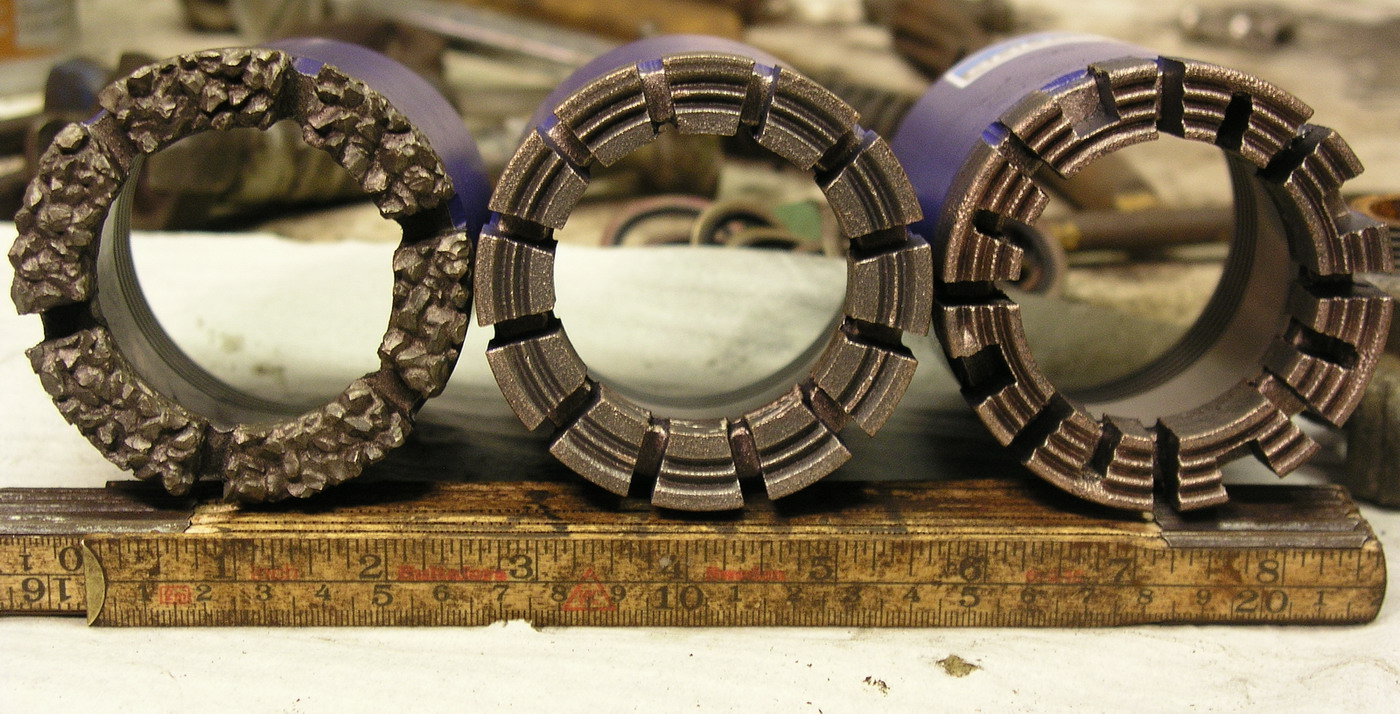|
Core Drilling
A modern core drill is a drill specifically designed to remove a cylinder of material, much like a hole saw. The material left inside the drill bit is referred to as the ''core''. Core drills used in metal are called annular cutters. Core drills used for concrete and hard rock generally use industrial diamond grit as the abrasive material and may be electrical, pneumatic or hydraulic powered. Core drills are commonly water cooled, and the water also carries away the fine waste as a slurry. For drilling masonry, carbide core drills can be used, but diamond is more successful when cutting through rebar. The earliest core drills were those used by the ancient Egyptians, invented in 3000 BC. Core drills are used for many applications, either where the core needs to be preserved (the drilling apparatus used in obtaining a core sample is often referred to as a corer), or where drilling can be done more rapidly since much less material needs to be removed than with a standard bit. ... [...More Info...] [...Related Items...] OR: [Wikipedia] [Google] [Baidu] |
Core Drill 06 2005
Core or cores may refer to: Science and technology * Core (anatomy), everything except the appendages * Core (laboratory), a highly specialized shared research resource * Core (manufacturing), used in casting and molding * Core (optical fiber), the signal-carrying portion of an optical fiber * Core, the central part of a fruit * Hydrophobic core, the interior zone of a protein * Nuclear reactor core, a portion containing the fuel components * Pit (nuclear weapon) or core, the fissile material in a nuclear weapon * Semiconductor intellectual property core (IP core), is a unit of design in ASIC/FPGA electronics and IC manufacturing * Atomic core, an atom with no valence electrons * Lithic core, in archaeology, a stone artifact left over from toolmaking Geology and astrophysics * Core sample, in Earth science, a sample obtained by coring ** Ice core * Core, the central part of a galaxy; see Mass deficit * Core (anticline), the central part of an anticline or syncline * Planetary ... [...More Info...] [...Related Items...] OR: [Wikipedia] [Google] [Baidu] |
Drilling Rig
A drilling rig is an integrated system that Drilling, drills wells, such as oil or water wells, or holes for piling and other construction purposes, into the earth's subsurface. Drilling rigs can be massive structures housing equipment used to drill water wells, oil wells, or natural gas extraction wells, or they can be small enough to be moved manually by one person and such are called auger (drill), augers. Drilling rigs can sample subsurface mineral deposits, test rock, soil and groundwater physical properties, and also can be used to install sub-surface fabrications, such as underground utilities, instrumentation, tunnels or wells. Drilling rigs can be mobile equipment mounted on trucks, tracks or trailers, or more permanent land or marine-based structures (such as oil platforms, commonly called 'offshore oil rigs' even if they don't contain a drilling rig). The term "rig" therefore generally refers to the complex equipment that is used to penetrate the surface of the Earth's ... [...More Info...] [...Related Items...] OR: [Wikipedia] [Google] [Baidu] |
Hole Saw
A hole saw (also styled holesaw), also known as a hole cutter, is a saw blade of annular (ring) shape, whose annular kerf creates a hole in the workpiece without having to cut up the core material. It is used in a drill. Hole saws typically have a pilot drill bit (arbor) at their center to keep the saw teeth from walking. The fact that a hole saw creates the hole without needing to cut up the core often makes it preferable to twist drills or spade drills for relatively large holes (especially those larger than . The same hole can be made faster and using less power. The depth to which a hole saw can cut is limited by the depth of its cup-like shape. Most hole saws have a fairly short aspect ratio of diameter to depth, and they are used to cut through relatively thin workpieces. However, longer aspect ratios are available for applications that warrant them. Common hole saw depths are 38, 45 and 60 mm and for drilling through e.g. (angled-) rooftop constructions also a de ... [...More Info...] [...Related Items...] OR: [Wikipedia] [Google] [Baidu] |
Annular Cutter
An annular cutter (also called a core drill, core cutter, broach cutter, trepanning drill, hole saw, or cup-type cutter) is a form of core drill used to create holes in metal. An annular cutter, named after the annulus shape, cuts only a groove at the periphery of the hole and leaves a solid core or slug at the center. An annular cutter is a more expensive and efficient alternative to spiral drill bits and standard hole saws. An annular cutter is similar to a hole saw but differs in geometry and material. The two most common types are high-speed steel (HSS) and tungsten carbide tipped (TCT). Like a hole saw, but unlike a spiral drill bit, an annular cutter cuts only the periphery of a hole, leaving a circular "slug" at the center. Annular cutters are best used with a drill press or magnetic drilling machine, both for their stability against high torque forces created by such a drill bit and lower RPMs compared to other types of drills. History The annular cutter was pate ... [...More Info...] [...Related Items...] OR: [Wikipedia] [Google] [Baidu] |
Ancient Egyptians
Ancient Egypt () was a cradle of civilization concentrated along the lower reaches of the Nile River in Northeast Africa. It emerged from prehistoric Egypt around 3150BC (according to conventional Egyptian chronology), when Upper and Lower Egypt were amalgamated by Menes, who is believed by the majority of Egyptologists to have been the same person as Narmer. The history of ancient Egypt unfolded as a series of stable kingdoms interspersed by the " Intermediate Periods" of relative instability. These stable kingdoms existed in one of three periods: the Old Kingdom of the Early Bronze Age; the Middle Kingdom of the Middle Bronze Age; or the New Kingdom of the Late Bronze Age. The pinnacle of ancient Egyptian power was achieved during the New Kingdom, which extended its rule to much of Nubia and a considerable portion of the Levant. After this period, Egypt entered an era of slow decline. Over the course of its history, it was invaded or conquered by a number of foreign civ ... [...More Info...] [...Related Items...] OR: [Wikipedia] [Google] [Baidu] |
Core Sample
A core sample is a cylindrical section of (usually) a naturally-occurring substance. Most core samples are obtained by drilling with special drills into the substance, such as sediment or rock, with a hollow steel tube, called a core drill. The hole made for the core sample is called the "core hole". A variety of core samplers exist to sample different media under different conditions; there is continuing development in the technology. In the coring process, the sample is pushed more or less intact into the tube. Removed from the tube in the laboratory, it is inspected and analyzed by different techniques and equipment depending on the type of data desired. Core samples can be taken to test the properties of manmade materials, such as concrete, ceramics, some metals and alloys, especially the softer ones. Core samples can also be taken of living things, including human beings, especially of a person's bones for microscopic examination to help diagnose diseases. Methods The ... [...More Info...] [...Related Items...] OR: [Wikipedia] [Google] [Baidu] |
Concrete
Concrete is a composite material composed of aggregate bound together with a fluid cement that cures to a solid over time. It is the second-most-used substance (after water), the most–widely used building material, and the most-manufactured material in the world. When aggregate is mixed with dry Portland cement and water, the mixture forms a fluid slurry that can be poured and molded into shape. The cement reacts with the water through a process called hydration, which hardens it after several hours to form a solid matrix that binds the materials together into a durable stone-like material with various uses. This time allows concrete to not only be cast in forms, but also to have a variety of tooled processes performed. The hydration process is exothermic, which means that ambient temperature plays a significant role in how long it takes concrete to set. Often, additives (such as pozzolans or superplasticizers) are included in the mixture to improve the physical prop ... [...More Info...] [...Related Items...] OR: [Wikipedia] [Google] [Baidu] |
Rock (geology)
In geology, rock (or stone) is any naturally occurring solid mass or aggregate of minerals or mineraloid matter. It is categorized by the minerals included, its Chemical compound, chemical composition, and the way in which it is formed. Rocks form the Earth's outer solid layer, the Earth's crust, crust, and most of its interior, except for the liquid Earth's outer core, outer core and pockets of magma in the asthenosphere. The study of rocks involves multiple subdisciplines of geology, including petrology and mineralogy. It may be limited to rocks found on Earth, or it may include planetary geology that studies the rocks of other celestial objects. Rocks are usually grouped into three main groups: igneous rocks, sedimentary rocks and metamorphic rocks. Igneous rocks are formed when magma cools in the Earth's crust, or lava cools on the ground surface or the seabed. Sedimentary rocks are formed by diagenesis and lithification of sediments, which in turn are formed by the weathe ... [...More Info...] [...Related Items...] OR: [Wikipedia] [Google] [Baidu] |
Exploration Diamond Drilling
Exploration diamond drilling is used in the mining industry to probe the contents of known ore deposits and potential sites. By withdrawing a small diameter core of rock from the orebody, geologists can analyze the core by chemical assay and conduct petrologic, structural, and mineralogical studies of the rock. It is also often used in the geotechnical engineering industry for foundation testing in conjunction with soil sampling methods. The technique is named for the diamond encrusted drill bit used. History Rodolphe Leschot is often cited as being the inventor of the first core bit in 1863. Early diamond drilling opened up many new areas for mineral mining, and was related to a boom in mineral exploration in remote locations. Before the invention of the portable diamond drill, most mineral prospecting was limited to finding outcrops at the surface and hand digging. In the late 1970s, General Electric pioneered the technology of polycrystalline diamond compacts (PDCs) as a re ... [...More Info...] [...Related Items...] OR: [Wikipedia] [Google] [Baidu] |
Drill String
A drill string on a drilling rig is a column, or string, of drill pipe that transmits drilling fluid (via the mud pumps) and torque (via the kelly drive or top drive) to the Well drilling#Drill bits in mechanical drilling, drill bit. The term is loosely applied to the assembled collection of the smuggler pool, drill collars, tools and drill bit. The drill string is hollow so that drilling fluid can be pumped down through it and circulated back up the Annulus (oil well), annulus (the void between the drill string and the casing/open hole). Components The drill string is typically made up of three sections: * Bottom hole assembly (BHA) * Transition pipe, which is often heavyweight drill pipe (HWDP) * Drill pipe Bottom hole assembly (BHA) The Bottom Hole Assembly (BHA) is made up of: a Well drilling#Drill bits in mechanical drillings, drill bit, which is used to break up the rock Geologic formation, formations; drill collars, which are heavy, thick-walled tubes used to a ... [...More Info...] [...Related Items...] OR: [Wikipedia] [Google] [Baidu] |
Oriented Core Goniometer Commonly Used When Logging Core
In mathematics, orientability is a property of some topological spaces such as real vector spaces, Euclidean spaces, surfaces, and more generally manifolds that allows a consistent definition of "clockwise" and "anticlockwise". A space is orientable if such a consistent definition exists. In this case, there are two possible definitions, and a choice between them is an orientation of the space. Real vector spaces, Euclidean spaces, and spheres are orientable. A space is non-orientable if "clockwise" is changed into "counterclockwise" after running through some loops in it, and coming back to the starting point. This means that a geometric shape, such as , that moves continuously along such a loop is changed into its own mirror image . A Möbius strip is an example of a non-orientable space. Various equivalent formulations of orientability can be given, depending on the desired application and level of generality. Formulations applicable to general topological manifolds often ... [...More Info...] [...Related Items...] OR: [Wikipedia] [Google] [Baidu] |
Drilling Technology
Drilling is a cutting process where a drill bit is spun to cut a hole of circular cross-section in solid materials. The drill bit is usually a rotary cutting tool, often multi-point. The bit is pressed against the work-piece and rotated at rates from hundreds to thousands of revolutions per minute. This forces the cutting edge against the work-piece, cutting off chips (swarf) from the hole as it is drilled. In rock drilling, the hole is usually not made through a circular cutting motion, though the bit is usually rotated. Instead, the hole is usually made by hammering a drill bit into the hole with quickly repeated short movements. The hammering action can be performed from outside the hole ( top-hammer drill) or within the hole ( down-the-hole drill, DTH). Drills used for horizontal drilling are called drifter drills. In rare cases, specially-shaped bits are used to cut holes of non-circular cross-section; a square cross-section is possible. Process Drilled holes are c ... [...More Info...] [...Related Items...] OR: [Wikipedia] [Google] [Baidu] |










